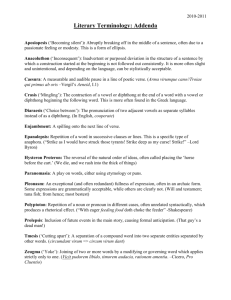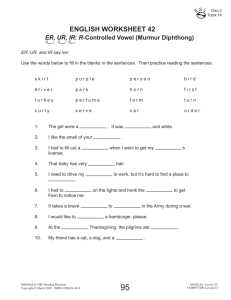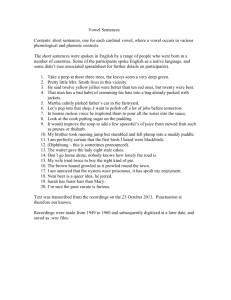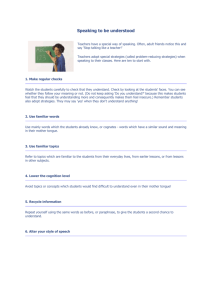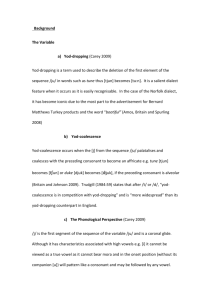here - National University of Singapore
advertisement
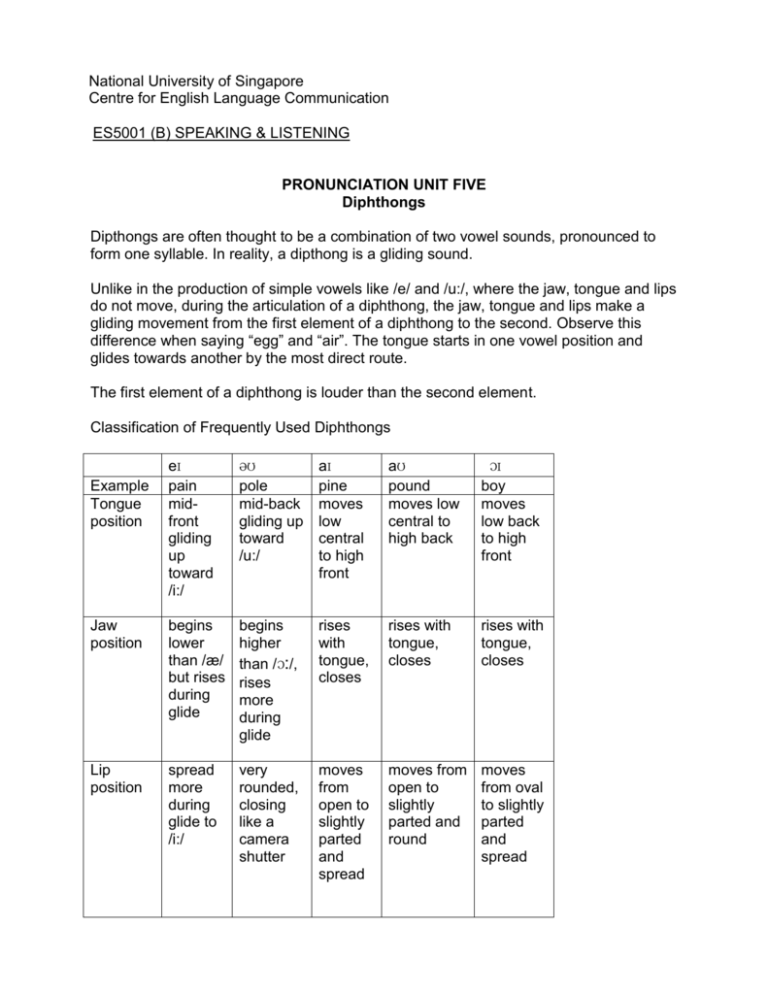
National University of Singapore Centre for English Language Communication ES5001 (B) SPEAKING & LISTENING PRONUNCIATION UNIT FIVE Diphthongs Dipthongs are often thought to be a combination of two vowel sounds, pronounced to form one syllable. In reality, a dipthong is a gliding sound. Unlike in the production of simple vowels like /e/ and /u:/, where the jaw, tongue and lips do not move, during the articulation of a diphthong, the jaw, tongue and lips make a gliding movement from the first element of a diphthong to the second. Observe this difference when saying “egg” and “air”. The tongue starts in one vowel position and glides towards another by the most direct route. The first element of a diphthong is louder than the second element. Classification of Frequently Used Diphthongs eɪ pain midfront gliding up toward /i:/ əʊ Jaw position begins lower than /æ/ but rises during glide Lip position spread more during glide to /i:/ Example Tongue position aɪ pine moves low central to high front aʊ pound moves low central to high back begins higher than /ɔ:/, rises more during glide rises with tongue, closes rises with tongue, closes rises with tongue, closes very rounded, closing like a camera shutter moves from open to slightly parted and spread moves from open to slightly parted and round moves from oval to slightly parted and spread pole mid-back gliding up toward /u:/ ɔɪ boy moves low back to high front More mate examples main mail weigh bathe boat tone foe goal hold might mine mile sigh tire bout town towel gown hound point loiter coy boil noise Three other diphthongs are /ɪə/, /ʊə/ and /eə/. 1. THE DIPTHONG /eɪ/ /eɪ/ is often mispronounced as /e/. By failing to raise the tongue towards /ɪ/ eight becomes /et/, make /mek/ and take /tek/. Or when there is too much raising of the tongue /eɪ / becomes /ei:/, resulting in /ei:t/, /mei:k/ and /tei:k/. Exercise 1: cake Say the following, avoiding the mistakes mentioned above. fail rain date nail sane late cane sale 2. THE DIPTHONG /əʊ/ To make this sound, first pronounce /ə/, then move up and back towards /ʊ/. The diphthong /əʊ/ is difficult when followed by /l/ or /n/. Try saying / əʊ/ + /l/ with a break between or /ə / + /ʊl/, then run them together. old hole fold əʊ - ld hə - əʊl fə - ʊld Try doing this with the following words: bone cone loan tone coal Exercise 2: Practise differentiating these sounds. /ɜ:/ kirk curl /əʊ/ coke coal 2 earn firm gird jerk work own foam goat joke woke 3. THE DIPHTHONG /ɑʊ/ To produce /ɑʊ/, start from the fully open position for /ɑ:/ and move towards /ʊ/. Exercise 3: Practise differentiating these sounds. /aʊ/ bound count shout town /a:/ barn can’t shan’t tart /əʊ/ bone cone shown tone 4. THE DIPHTHONG /aɪ/ To produce /aɪ/, start from the fully open position for /a:/ and move towards /ɪ/ . Exercise 4: Say the following words, taking care to raise the tongue towards /ɪ/. height choir liar society tired riot 5. THE DIPHTHONG /ɪə/ During the production of /ɪə/ the distance between the jaws widens. /ɪə/ is often mispronounced as /i:ə/ Word beard Correct bɪəd Incorrect ɪəd near nɪə ni:ɪə here hɪə hi:ɪə 3 Exercise 5: Say the following clearly. /i:/ bead feet glee peace /ɪ/ bid fit gimmick pit /ɜ:/ bird fur gird perch /ɪə/ beard fear gear pier 6. THE DIPHTHONG /ɔɪ/ To produce /ɔɪ/ the back of the tongue is raised to half open position before it moves towards /ɪ/. Exercise 6. Say these words to a partner, taking care to sound the vowel or diphthong in each word. Can your partner hear which word of each minimal pair is read? toil loyal ointment annoy oil tore lawyer omen anonymous all 7. THE DIPHTHONG /eə/ The first part of this diphthong is more open than the short vowel /e/ in pen, then glides to /ə/. The lips remain neutrally open. Suggestion: Most native speakers use /æ/ as the starting point of this diphthong. Exercise 7: Read the following clearly. there bear their careful hair wear glare scarce 4 spare care 8. THE DIPTHONG /ʊə/ To produce /ʊə/, the front of the back of the tongue is raised and then it moves towards /ə/. /ʊə/ is often mispronounced as /u:ə/. Suggestion: Practise the /ʊ/ sound first and then practise the glide from /ʊ/ to /ə/. Exercise 8: Contrasting /u:/ and /ʊə/. /u:/ blue queue shoe true /ʊə/ bluer cure sure truer Exercise 9: Extended Practice Identify the diphthongs in the following sentences and read the sentences. 1. He sold a whole gross of combs in Rome. 2. Penny wise, pound foolish. 3. Count the vowel sounds in this noun. 4. Beer, beer, Qingtao beer, makes me tear and cheer. 5. The poor steward endured the cruel treatment of his furious pilot. 6. Jane is late again, so she’ll be paid eighty cents less. 7. The annoyed oyster disturbed by the noise from the engines closed its flowery shell. References: Huang, R. (1983). English Pronunciation. HK: Hongkong University Press. Celce-Murcia, M., Brinton, D.M., and Goodwin, J.M. (1996). Teaching Pronunciation. US: Cambridge University Press. 5
